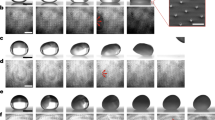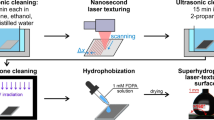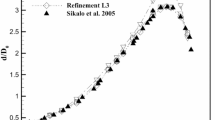Abstract
Preventing water droplet accretion on surfaces is fundamentally interesting and practically important. Water droplets at room temperature can spontaneously detach from surfaces through texture design or coalescence-induced surface-to-kinetic energy transformation. However, under freezing conditions, these strategies become ineffective owing to the stronger droplet–surface interaction and the lack of an energy transformation pathway. Leveraging water volume expansion during freezing, we report a structured elastic surface with spring-like pillars and wetting contrast that renders the spontaneous ejection of freezing water droplets, regardless of their impacting locations. The spring-like pillars can store the work done by the seconds-long volume expansion of freezing droplets as elastic energy and then rapidly release it as kinetic energy within milliseconds. The three-orders-of-magnitude reduction in timescales leads to sufficient kinetic energy to drive freezing droplet ejection. We develop a theoretical model to elucidate the factors determining the successful onset of this phenomenon. Our design is potentially scalable in manufacturing through a numbering-up strategy, opening up applications in deicing, soft robotics and power generation.

This is a preview of subscription content, access via your institution
Access options
Subscribe to this journal
Receive 12 digital issues and online access to articles
$119.00 per year
only $9.92 per issue
Buy this article
- Purchase on SpringerLink
- Instant access to full article PDF
Prices may be subject to local taxes which are calculated during checkout




Similar content being viewed by others
Data availability
All data are available in the Article and its Supplementary Information. Source data are provided with this paper.
Code availability
Code is available from the corresponding authors upon reasonable request.
References
Xu, W. et al. A droplet-based electricity generator with high instantaneous power density. Nature 578, 392–396 (2020).
Boreyko, J. B. & Chen, C.-H. Self-propelled dropwise condensate on superhydrophobic surfaces. Phys. Rev. Lett. 103, 184501 (2009).
Geyer, F. et al. When and how self-cleaning of superhydrophobic surfaces works. Sci. Adv. 6, eaaw9727 (2020).
Kreder, M. J., Alvarenga, J., Kim, P. & Aizenberg, J. Design of anti-icing surfaces: smooth, textured or slippery? Nat. Rev. Mater. 1, 15003 (2016).
Lv, J., Song, Y., Jiang, L. & Wang, J. Bio-inspired strategies for anti-icing. ACS Nano 8, 3152–3169 (2014).
Barthlott, W. & Neinhuis, C. Purity of the sacred lotus, or escape from contamination in biological surfaces. Planta 202, 1–8 (1997).
Bohn, H. F. & Federle, W. Insect aquaplaning: Nepenthes pitcher plants capture prey with the peristome, a fully wettable water-lubricated anisotropic surface. Proc. Natl Acad. Sci. USA 101, 14138–14143 (2004).
Wong, T.-S. et al. Bioinspired self-repairing slippery surfaces with pressure-stable omniphobicity. Nature 477, 443–447 (2011).
Wisdom, K. M. et al. Self-cleaning of superhydrophobic surfaces by self-propelled jumping condensate. Proc. Natl Acad. Sci. USA 110, 7992–7997 (2013).
Kasahara, M. et al. Liquid marbles in nature: craft of aphids for survival. Langmuir 35, 6169–6178 (2019).
Liu, Y. et al. Pancake bouncing on superhydrophobic surfaces. Nat. Phys. 10, 515–519 (2014).
Mukherjee, R., Berrier, A. S., Murphy, K. R., Vieitez, J. R. & Boreyko, J. B. How surface orientation affects jumping-droplet condensation. Joule 3, 1360–1376 (2019).
Bird, J. C., Dhiman, R., Kwon, H.-M. & Varanasi, K. K. Reducing the contact time of a bouncing drop. Nature 503, 385–388 (2013).
Schutzius, T. M. et al. Spontaneous droplet trampolining on rigid superhydrophobic surfaces. Nature 527, 82–85 (2015).
Richard, D., Clanet, C. & Quéré, D. Contact time of a bouncing drop. Nature 417, 811–811 (2002).
Gauthier, A., Symon, S., Clanet, C. & Quéré, D. Water impacting on superhydrophobic macrotextures. Nat. Commun. 6, 8001 (2015).
Boinovich, L. B., Emelyanenko, A. M., Ivanov, V. K. & Pashinin, A. S. Durable icephobic coating for stainless steel. ACS Appl. Mater. Interfaces 5, 2549–2554 (2013).
Boinovich, L. B. & Emelyanenko, A. M. Anti-icing potential of superhydrophobic coatings. Mendeleev Commun. 1, 3–10 (2013).
Graeber, G., Schutzius, T. M., Eghlidi, H. & Poulikakos, D. Spontaneous self-dislodging of freezing water droplets and the role of wettability. Proc. Natl Acad. Sci. USA 114, 11040–11045 (2017).
Golovin, K., Dhyani, A., Thouless, M. & Tuteja, A. Low–interfacial toughness materials for effective large-scale deicing. Science 364, 371–375 (2019).
Golovin, K. & Tuteja, A. A predictive framework for the design and fabrication of icephobic polymers. Sci. Adv. 3, e1701617 (2017).
Irajizad, P., Hasnain, M., Farokhnia, N., Sajadi, S. M. & Ghasemi, H. Magnetic slippery extreme icephobic surfaces. Nat. Commun. 7, 13395 (2016).
Yang, S. et al. Photothermal superhydrophobic copper nanowire assemblies: fabrication and deicing/defrosting applications. Int. J. Extreme Manuf. 5, 045501 (2023).
Kim, P. et al. Liquid-infused nanostructured surfaces with extreme anti-ice and anti-frost performance. ACS Nano 6, 6569–6577 (2012).
Liu, K. et al. Janus effect of antifreeze proteins on ice nucleation. Proc. Natl Acad. Sci. USA 113, 14739–14744 (2016).
Bi, Y., Cao, B. & Li, T. Enhanced heterogeneous ice nucleation by special surface geometry. Nat. Commun. 8, 15372 (2017).
Wu, S. et al. Heterogeneous ice nucleation correlates with bulk-like interfacial water. Sci. Adv. 5, eaat9825 (2019).
Jung, S. et al. Are superhydrophobic surfaces best for icephobicity? Langmuir 27, 3059–3066 (2011).
Lambley, H. et al. Freezing-induced wetting transitions on superhydrophobic surfaces. Nat. Phys. 19, 649–655 (2023).
Yang, S. et al. Condensation frosting and passive anti-frosting. Cell Rep. Phys. Sci. 2, 100474 (2021).
Knopf, D. A. & Alpert, P. A. Atmospheric ice nucleation. Nat. Rev. Phys. 5, 203–217 (2023).
Chu, F. et al. Interfacial ice sprouting during salty water droplet freezing. Nat. Commun. 15, 2249 (2024).
Jung, S., Tiwari, M. K., Doan, N. V. & Poulikakos, D. Mechanism of supercooled droplet freezing on surfaces. Nat. Commun. 3, 615 (2012).
Mills, A. The freezing bomb. Phys. Educ. 45, 153 (2010).
Page, R. M. Sporangium discharge in Pilobolus: a photographic study. Science 146, 925–927 (1964).
Money, N. P. in The Fungi (Third Edition) (eds Watkinson, S. C., Boddy, L. & Money, N. P.) 67–97 (Academic Press, 2016).
Raraty, L. & Tabor, D. The adhesion and strength properties of ice. Proc. Math. Phys. Eng. Sci. 245, 184–201 (1958).
Luo, D. et al. Autonomous self-burying seed carriers for aerial seeding. Nature 614, 463–470 (2023).
Zhang, W. et al. Honeybee comb-inspired stiffness gradient-amplified catapult for solid particle repellency. Nat. Nanotechnol. 19, 219–225 (2023).
Griffith, A. A. VI. The phenomena of rupture and flow in solids. Philos. Trans. R. Soc. A 221, 163–198 (1921).
Yao, H. & Zhang, C. A generalized solution to the combo-crack problem—I. Pressure load on crack surface. J. Mech. Phys. Solids 159, 104783 (2022).
Acknowledgements
We acknowledge financial support from the Research Grants Council of Hong Kong (no. 15237824, Z.W.; no. SRFS2223-1S01, Z.W.; no. C1006-20W, Z.W.; no. 11218321, Z.W.; no. 11219219, Z.W.), the Tencent Foundation through the XPLORER PRIZE (Z.W.) and the Meituan Foundation through the Green Tech Award (Z.W.).
Author information
Authors and Affiliations
Contributions
Z.W. and H.Z. conceived the research. Z.W. and H.Y. supervised the research. H.Z., Y.J. and C.W. prepared the samples. H.Z., Y.J., C.W., and Z.X. designed and carried out the experiments. H.Z., S.Y., S.G. and F.L. analyzed the data. H.Y., H.Z. and W.Z. developed the theoretical modeling. Z.W., H.Y., W.Z., H.Z. and S.W. wrote the manuscript. All authors reviewed and approved the data.
Corresponding authors
Ethics declarations
Competing interests
The authors declare no competing interests.
Peer review
Peer review information
Nature Chemical Engineering thanks Jonathan Boreyko and the other, anonymous, reviewer(s) for their contribution to the peer review of this work.
Additional information
Publisher’s note Springer Nature remains neutral with regard to jurisdictional claims in published maps and institutional affiliations.
Extended data
Extended Data Fig. 1 Energy conversion for spore dispersal in the fungus (Pilobolus kleinii).
a, Photograph of the fungus (Pilobolus kleinii). Reproduced with permission from36. Copyright 2016 Elsevier. b, Snapshots showing the spore dispersal behavior of the fungus driven by the conversion of elastic-to-kinetic energy. Reproduced with permission from36. Copyright 2016 Elsevier. c, Schematics of the mechanism of the energy conversion process in the fungus.
Extended Data Fig. 2 Fabrication and mechanical characterization of the SES.
a, Schematic illustration of the fabrication process of the SES. We fabricate the SES using the cast-molding method based on the 3D-printed masters. d and h, the diameter and height of the micropattern; w, the center-to-center spacing between the micro patterns; \({h}_{{\rm{p}}}\), the height of the pillar; \({R}_{{\rm{b}}}\), the radius of the smooth base. b, Compression tests of SES made of PDMS with different base/cross-linker ratios by weight. The compressive modulus (Kc) equals the stress value when the strain reaches 1.
Extended Data Fig. 3 Contact angle characterization.
Contact angle of the water droplet on the SES.
Extended Data Fig. 4 Schematic of the experimental setup for the freezing droplet ejection.
The droplet on the SES is cooled down by the chilly air circulated at ~1 m/s within an isothermal environmental chamber (~−15 °C).
Extended Data Fig. 5 Optical and thermographic imaging of the water droplet freezing process on the SES sample.
The uniform temperature distribution within the SES illustrates that the droplet is cooled down by the circulated chilly air in the isothermal chamber.
Extended Data Fig. 6 Influence of freezing conditions on pillar dynamics.
Real-time compression ratio of the pillar under two different freezing conditions, −15 °C and −5 °C.
Extended Data Fig. 7 The dynamic competition between the pressure-bearing capacity of the ice shell Pi and the internal pressure Pp.
Here \({\phi }_{0}^{* }\) denotes the critical value of the fraction of the solidified water (\({\phi }_{0}\)), whereby the ice shell will not fracture in the subsequent compression-rebound cycle.
Extended Data Fig. 8 The maximal compression ratio \({\overline{\delta }}_{\max }\) as a function of the volume ratio of a droplet to a pillar Vd/Vp under different Kc.
It can be found that \({\bar{\delta }}_{\max }\) first increases as \({V}_{{\rm{d}}}/{V}_{{\rm{p}}}\) increases and then reaches a plateau of 1. Here, the fracture strength of ice is taken as \({\sigma }_{{\rm{i}}}=0.3{\rm{MPa}}\). Additionally, \({\bar{\delta }}_{\max }\) exhibits a negative dependence on \({K}_{{\rm{c}}}\). For a given \({V}_{{\rm{d}}}/{V}_{{\rm{p}}}\), the higher \({K}_{{\rm{c}}}\) the lower \({\bar{\delta }}_{\max }\).
Extended Data Fig. 9 Theoretical modeling for determining the maximum traction force between the freezing droplet and the base.
a, Schematics showing a snapshot of the separation process between a freezing droplet and the base of SES. b, The variation of the normalized traction force \({(F}_{{\rm{t}}}/\uppi {R}_{{\rm{p}}}^{2}{P}_{{\rm{atm}}})\) with the radius ratio between the inner and outer contact edges for different \({R}_{{\rm{b}}}/{R}_{{\rm{p}}}\). Here, the normalized fracture toughness of the interface was assumed as \(\frac{{{\mathscr{K}}}_{{\rm{Ic}}}}{{P}_{{\rm{atm}}}\sqrt{{R}_{{\rm{p}}}}\,}=0.5\) with \({{\mathscr{K}}}_{{\rm{Ic}}}\) being the critical stress intensity factor for interfacial delamination. c, Dependence of the maximum normalized traction force (the peak values on the curves in b\()\) on the radius ratio between the base and pillar \(({R}_{{\rm{b}}}/{R}_{{\rm{p}}})\).
Supplementary information
Supplementary Video 1
Ejection behavior of the freezing water droplet on the SES under isothermal freezing conditions, inspired by a fungus.
Supplementary Video 2
Synchronous thermographic and optical imaging of the freezing process of a water droplet on the SES. The uniform temperature distribution (at this scale) illustrates that the droplet is cooled down by the circulated chilly air in the isothermal chamber.
Supplementary Video 3
Comparison of droplet ejection behaviors under two different freezing conditions: –15 °C and –5 °C.
Supplementary Video 4
Demonstration of chain ejection capability of the SES.
Supplementary Video 5
Scalability demonstration of 3 × 3 SES arrays where nine droplets are ejected from the surface to reduce residual ice.
Supplementary Video 6
Absence of ejection behavior of the water droplet on the SES under bottom-up freezing conditions.
Source data
Source Data Fig. 3
Source data for Fig. 3.
Source Data Fig. 4
Source data for Fig. 4.
Source Data Extended Data Fig./Table 6
Source data for Extended Data Fig. 6.
Rights and permissions
Springer Nature or its licensor (e.g. a society or other partner) holds exclusive rights to this article under a publishing agreement with the author(s) or other rightsholder(s); author self-archiving of the accepted manuscript version of this article is solely governed by the terms of such publishing agreement and applicable law.
About this article
Cite this article
Zhang, H., Zhang, W., Jin, Y. et al. Freezing droplet ejection by spring-like elastic pillars. Nat Chem Eng 1, 765–773 (2024). https://doi.org/10.1038/s44286-024-00150-1
Received:
Accepted:
Published:
Issue date:
DOI: https://doi.org/10.1038/s44286-024-00150-1
This article is cited by
-
Cryo-electron tomography reconstructs polymer in liquid film for fab-compatible lithography
Nature Communications (2025)



